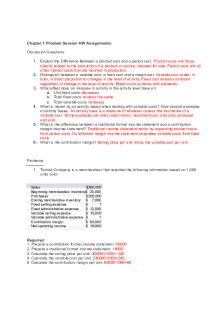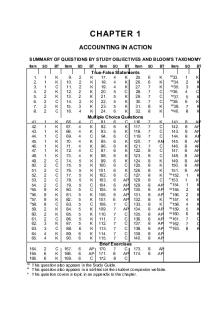Accounting chapter 1 summary PDF

| Title | Accounting chapter 1 summary |
|---|---|
| Course | Accounting |
| Institution | Victorian Certificate of Education |
| Pages | 2 |
| File Size | 50 KB |
| File Type | |
| Total Downloads | 3 |
| Total Views | 205 |
Summary
Accounting chapter 1 summary...
Description
CHAPTER 1 SUMMARY Accounting is the collection and recording of financial data, and the reporting, analysis and interpretation of financial information Purpose of accounting: To provide financial information to assist decision-making Factors that influence success of business: -Consumer tastes and demand -Level of competition -Quality of their staff/ employees -Economic climate -Management skills of the owners Financial data: Raw facts and figures upon which financial information is based Financial information: Financial data that has been sorted, classified and summarised into a more useable and understandable form Transaction: An exchange of goods and services with another party
THE ACCOUNTING PROCESS 1. Collecting source documents —> 2. Recording —> 3. Reporting —> 4. Advice 1. Source documents provide evidence that a transaction has occurred and the details of the transaction itself (input stage) TYPES OF SOURCE DOCUMENTS -Receipts -Cheque butts -Invoices -Memos 2. Sorting, classifying and summarising the data contained in the source documents so that it is more useable COMMON ACCOUNTING RECORDS -Journals -Ledgers -Stock cards -Subsidiary records
3. The preparation of financial statements that communicate financial information to the owner (output stage) REPORTS THAT ALL BUSINESS SHOULD PREPARE -Cash flow statement -Income statement -Balance sheet 4. The accountant should be able to offer advice by making some suggestions about an appropriate course of action or presenting owners with a range of options from which they can choose After recording in Journals is done ledgers are then made followed by balance day adjustments and reports
ACCOUNTING CHAPTER 2 SUMMARY Assets= Liabilities + Owners Equity If the left hand side of the accounting equation increases its a DEBIT If the right hand side of the accounting equation increases its a CREDIT
DOUBLE ENTRY ACCOUNTING System that records two effects on the accounting equation as a result of each transaction Rules of double entry accounting: 1. Every transaction will affect at least two items in the accounting equation 2. After recording these changes, the accounting equation must still balance
TYPE OF ACCOUNT
INCREASE
DECREASE
Asset
Debit
Credit
Liability
Credit
Debit
Owners Equity
Credit
Debit
Revenue
Credit
Debit
Expense
Debit
Credit...
Similar Free PDFs

Accounting chapter 1 summary
- 2 Pages

Financial Accounting 1 summary Valix
- 41 Pages

Chapter 1 Accounting 220
- 3 Pages

Managerial accounting chapter 1
- 11 Pages

Advanced Accounting - Chapter 1
- 13 Pages
Popular Institutions
- Tinajero National High School - Annex
- Politeknik Caltex Riau
- Yokohama City University
- SGT University
- University of Al-Qadisiyah
- Divine Word College of Vigan
- Techniek College Rotterdam
- Universidade de Santiago
- Universiti Teknologi MARA Cawangan Johor Kampus Pasir Gudang
- Poltekkes Kemenkes Yogyakarta
- Baguio City National High School
- Colegio san marcos
- preparatoria uno
- Centro de Bachillerato Tecnológico Industrial y de Servicios No. 107
- Dalian Maritime University
- Quang Trung Secondary School
- Colegio Tecnológico en Informática
- Corporación Regional de Educación Superior
- Grupo CEDVA
- Dar Al Uloom University
- Centro de Estudios Preuniversitarios de la Universidad Nacional de Ingeniería
- 上智大学
- Aakash International School, Nuna Majara
- San Felipe Neri Catholic School
- Kang Chiao International School - New Taipei City
- Misamis Occidental National High School
- Institución Educativa Escuela Normal Juan Ladrilleros
- Kolehiyo ng Pantukan
- Batanes State College
- Instituto Continental
- Sekolah Menengah Kejuruan Kesehatan Kaltara (Tarakan)
- Colegio de La Inmaculada Concepcion - Cebu










